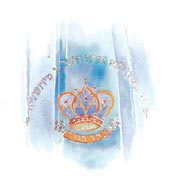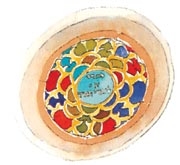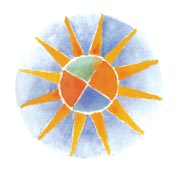|
The Ancient
Cemetery
of Safed
For over 2,000 years, the
western slope of Safed has served as the cemetery of the city’s Jewish
community. The number of graves in the cemetery is unknown. The registration
documents vanished about 70 years ago. Earthquakes and landslides added to the
confusion. Nevertheless, the cemetery attracts more than 700,000 visitors each
year – who come to make a pilgrimage to the graves of saints, rabbis, and
central figures in the history of the Jewish people.
Buried
in the cemetery are the famous rabbis, Yitzhak Luria – Ha’ari, Shlomo Alkabetz,
Moshe Cordovero, Yosef Caro, Moshe Mitrani – the Mabit, Moshe Alsheikh, and
others. Other popular pilgrimage sites are the graves of Rabbi Leibel Ba’al
HaYissurim, Rabbi Pinchas Ben Ya’ir, Hannah and her seven sons and
the grave of the prophet Hosea. Burial in the ancient cemetery was halted in the
1960s and a new cemetery was opened at the foot of the slope.
Over the
years, the cemetery was neglected. Apart from cosmetic modifications 15
years ago, its condition deteriorated and its footpaths became hazardous. In the
early 1990s, it was decided to rehabilitate the cemetery. The project is
currently in progress.
Tour
of the Cemetery
Begin the tour on the slopes that enter the cemetery below the Sephardic
Ha’ari Synagogue (at the end of Ha’ari Street). At the bottom of the stairs, to
the left, you can see a path that leads toward the mikveh of Ha’ari. The mikveh
is built over a spring in whose waters, legend has it, Ha’ari used to immerse
himself. Entrance is for men only.
Continue
on the path leading to the plaza of Ha’ari’s grave. Here, in addition to Ha’ari,
you will find the graves of his son Moshe, Rabbi Shlomo Alkabetz, and Rabbi
Moshe Cordovero. Descend southward down the stairs to the grave of Rabbi Moshe
Alsheikh (painted blue). Continue down the steps to the grave of Rabbi
Yosef Caro. Further down the slope, to the south, are a series of caves. Here
you will find the grave of Rabbi Ya’acov Beirav. In the nearby building, the
grave of the prophet Hosea is shown.
At the
bottom of the hill is the new cemetery. At the edge of the cemetery there is a wide
plaza with a tree growing in its center. The tree is bedecked with scarves
and plastic bags. Under the tree is the grave of Rabbi Pinhas Ben Ya’ir.
Pilgrims customarily circle the grave seven times while praying.
Climb back to the plaza of Ha’ari’s grave and follow the
path leading north. This will lead you to another part of the cemetery, beside
the monument to the underground fighters who were hanged in Acre by the British.
On the way, you will pass beneath the plots where the victims of the
earthquake of 1837 and of the epidemic and hunger of World War I are buried.
When you reach the monument, continue north toward a grave painted blue that is a
little below you on the slope. This is the grave of Rabbi Leibel Ba’al
HaYissurim. It is customary to pray here for an easy birth. Return to the
monument and walk up the stairs toward the military cemetery. Most of the graves
here, crowded up against each other, are from the early 1900s. The path passes
through the military cemetery and leads back to Ha’ari Street.
|
|
ZADDIKS, RABBIS AND
SAGES Rabbis of Safed |
|
Rabbi Moshe Alsheich |
|
Born in 1508 in Edirne, Turkey. Like many of
the other rabbinical students who made aliyah to
Safed in the 16th century, he
had studied in the Yeshiva of Rabbi Joseph Taitachek in Saloniki. Full of
messianic hopes, he settled in Safed, where he was ordained as a rabbi by Rabbi
Joseph Karo. Following his ordination, he opened his own yeshiva. Among his
students was Haim Vital, later to become the foremost pupil of the Ari.
In 1578, following a plague of typhoid and hunger in Safed, Alsheich
settled in Damascus. In Damascus, he published his foremost work: "Torat Moshe"
(Moses' Teachings) - a collection of his sermons on the weekly biblical reading.
The book, known as the "Holy Alsheich," is one of the most popular and loved
biblical interpretations to this day. After spending some time in Damascus, Alsheich returned to Safed. He died circ. 1600 and is buried in the ancient
cemetery in Safed. One of the Alsheich's hymn's (piyut) is recited during the
midnight tikkun during the month of Elul.
|
|
Rabbi Yitzhak Luria
Ashkenazi (Ha'Ari) |
|
Born
in Jerusalem, he lost his father at a young age and grew up in his uncle’s home
in Egypt. At the age of 15, he married his uncle’s daughter, and began
to delve into the Torah. For six years after his marriage, he secluded himself
in a small house on the banks of the Nile and would only go home on Saturdays.
His ascetic lifestyle became famous and people from all over Egypt made pilgrimages to
see him. In 1569, at the age of 35, he moved to Safed in order to study Kabbalah
with Rabbi Moshe Cordovero, but Cordovero died a short time after Ha’ari’s
arrival. Ha’ari continued his kabbalistic studies on his own. Around him
gathered pupils who were known as gurei ha’ari (the lion’s cubs), who studied
his unique system of Kabbalah. Ha’ari was active in Safed for a little more than
two years, until his death in 1572. He is buried in the old cemetery in Safed. |
|
Rabbi Ya'acov Beirav |
|
Born
in 1475 in Castile, Spain. Studied Torah under the tutelage of Rabbi Yitzhak
Abuhav. At the time of the expulsion from Spain, when he was 18 years old, he
moved to North Africa and was appointed rabbi of the city of Fez. Several years
later, he moved to Egypt, opened a business and became a wealthy man. Once he
had acquired wealth, he left his business, settled in Safed, and became the head
of a yeshiva. Among his pupils were Yosef Caro, Moshe Cordovero, Moshe De
Mitrani (the Mabit), and others. He was regarded in his time as the rabbi of the
sages of Safed.
Beirav tried to reinstate the practice of ordination of rabbis, which would have
turned the Land of Israel into the center of the Jewish world and also,
according to mysticism, hastened the arrival of the messiah. But, due to the
opposition of the chief rabbi of Jerusalem, who was insulted because he was not
consulted from the beginning, the daring attempt failed.
After someone tipped off the Turkish authorities about his activities, Beirav
fled to Damascus. He apparently returned to Safed a short time later. Beirav
died on the first day of Iyar 1546. He is buried in the old cemetery in Safed. |
|
Rabbi Yosef Caro |
|
Born in
Spain in 1488, Caro came to Safed in 1536. He was four years old at the time of
the Expulsion from Spain. His family wandered around the Mediterranean countries
before settling in Istanbul. When he grew up, he moved to Edirne, married, and
founded a yeshiva. At the age of 34, he began his life’s work, the book Beit
Yosef, in which he assembled the opinions of all of the rabbinical
interpreters of the Jewish law (poskim in Hebrew) until his time, and decided which
rulings were the definitive ones. After the death of his wife, he remarried.
Subsequently he made his way to the yeshiva of Rabbi Yosef Teitachek in Salonika.
There he befriended Shlomo Molcho, a fellow student. After settling in Safed he was
ordained as a rabbi by Ya’acov Beirav. For 20 years, he secluded himself in a
little alcove, compiling Beit
Yosef. When the book was completed, he spent 12 years proofreading it. He
then produced a concise version that he called Shulhan Aruch. This work
has become the main reference for the interpretation of the hallakah. After the death of his second wife, when
he was over 80 years old, he married the daughter of a Jerusalem sage, who bore
him his second son, Yehuda. Caro died on Passover eve, 1575, at the age of 87,
and is buried in the cemetery in Safed. |
|
Rabbi Moshe Cordovero
(The Ramak) |
|
Born ca. 1522. A
descendant of Spanish exiles from Cordova. He was the youngest pupil of Ya’acov
Beirav, studying for his rabbinical ordination just after he turned 13. When
Beirav fled to Damascus, Cordovero a continued his studies with Caro, but since
Caro was not a kabbalist, Cordovero soon transferred to Caro's son-in-law,
the poet Rabbi Shlomo Alkabetz.
Cordovero initiated the kabbalist custom of studying in nature and visiting the
graves of ancient ages in the mountains of the Galilee. He called these nature
trips Gerushin - from the Hebrew word Migrash, a plot of
land - and he described the walks in his book, Sefer Hagerushin.
His major work was Pardes Rimonim (An Orchard of Pomegranates), one of
the most important works on Kabbalah to be published. He died in 1570 and is
buried in the ancient cemetery of Safed. |
|

|
The Alsheich Synagogue
The Alsheich Synagogue in the Old City of Safed is the only synagogue that
survived intact following the earthquakes of 1759 and 1837.
The synagogue was probably founded by Anosim - forced converts to Christianity,
who managed to escape from Spain in 1391 and converted back to Judaism.
The synagogue is built in the style of the Spanish synagogues of the 16th
century.
The synagogue, with its beautiful painted wall decorations, was renovated just
before the massive earthquake of 1837. The renovation works probably saved the
building from destruction. An inscription on the walls commemorating the
renovation works mentions three people: The builder Ya'akov Faligi, the
sponsor Yehezkel Reuven Menashe, and the lobbyist Rabbi Ya'akov Anavati.
Anavati is known to us for being the rabbi of Damascus in 1840 during the infamous
Damascus Blood Libel.
 |
|
The Sephardic
Ha’ari Synagogue
Considered the oldest synagogue
in Safed. It is mentioned in historical sources as early as 1522 as the
synagogue of the Jews of North Africa, then called Eliyahu Hanavi (the prophet
Elijah) Synagogue. Ha’ari preferred to pray in this synagogue due to the
view of Mount Meron and the grave of Rabbi Shimon Bar Yohai, which could be
seen through the window.
It is said that Ha’ari liked to sit in a little alcove on the eastern side of
the synagogue, studying and deciphering secrets of the Kabbalah. In the
alcove the prophet Elijah, Ha’ari’s personal maggid, revealed himself to him. It
seems that the synagogue began to be called Ha’ari Synagogue in the seventeenth
century.
Despite its ancient, fortresslike appearance, most of the original synagogue was
destroyed in the massive earthquakes that struck Safed in 1759 and 1837. In
1840, the Italian Jewish philanthropist Yitzhak Guetta donated money for the
rehabilitation of the synagogue. A plaque commemorating the renewal hangs above
the entrance.
During Israel’s War of Independence the synagogue was an important position in
the defense of the Jewish Quarter. During the siege of Safed, the defenders
removed the Torah scrolls from the synagogue and bore shooting positions in the
walls of the building.
In the years that followed the establishment of the State of Israel, the
building was neglected. In the 1980s and '90s, the large complex of the Braslav
Hassidim was built around the synagogue.
At present, the beautiful building is usually closed, except for a few hours a
week when Torah lessons are held in the synagogue.

|
|

